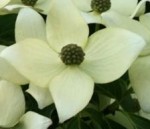 Native to Japan, Korea, and China, kousa dogwood is a small deciduous flowering tree or large shrub that is covered with flowers in late spring. The branches are at first upright but become more horizontal and tiered with maturity. Older bark becomes mottled with gray-and tan. The pointed oval leaves are 2-4 inches long and .75 to 1 inch wide. They are dark medium green in summer but turn red-purple in fall. The “flowers” are actually a cluster of tiny green flowers surrounded by four white pointed bracts one to two inches long. They appear in late spring facing upward and last for six weeks, turning pink before giving way to berry-like pink to red roundish fruits that persist into winter and are attractive to birds. Similar to flowering dogwood (Cornus florida), kousa dogwood can be distinguished by its pointed white flower bracts, later bloom time, more upright habit and greater resistance to anthracnose. An outstanding choice as a specimen tree or planted in small groups especially when associated with woodland gardens. The genus name, Cornus, comes from the Latin word, cornus, meaning horn and probably refers to the strength of the wood. The specific name, kousa, is the Japanese name for the tree. Cultivars are available with pink flower bracts and variegated leaves.
Native to Japan, Korea, and China, kousa dogwood is a small deciduous flowering tree or large shrub that is covered with flowers in late spring. The branches are at first upright but become more horizontal and tiered with maturity. Older bark becomes mottled with gray-and tan. The pointed oval leaves are 2-4 inches long and .75 to 1 inch wide. They are dark medium green in summer but turn red-purple in fall. The “flowers” are actually a cluster of tiny green flowers surrounded by four white pointed bracts one to two inches long. They appear in late spring facing upward and last for six weeks, turning pink before giving way to berry-like pink to red roundish fruits that persist into winter and are attractive to birds. Similar to flowering dogwood (Cornus florida), kousa dogwood can be distinguished by its pointed white flower bracts, later bloom time, more upright habit and greater resistance to anthracnose. An outstanding choice as a specimen tree or planted in small groups especially when associated with woodland gardens. The genus name, Cornus, comes from the Latin word, cornus, meaning horn and probably refers to the strength of the wood. The specific name, kousa, is the Japanese name for the tree. Cultivars are available with pink flower bracts and variegated leaves.
Type: Flowering deciduous tree
Outstanding Features: Flowers, fall coloration, exfoliating bark
Form: Vase-shape to rounded with maturity
Growth Rate: Slow to medium
Bloom: Showy white pointed bracts surround tiny greenish flowers in late spring.
Size: 15-30’ H x 15-30’ W
Light: Full sun to part shade
Soil: Humusy, moist, well-drained, acidic to neutral
Hardiness: Zones 5-8
Care: Low maintenance
Pests and Diseases: Less susceptible to anthracnose than C. florida.